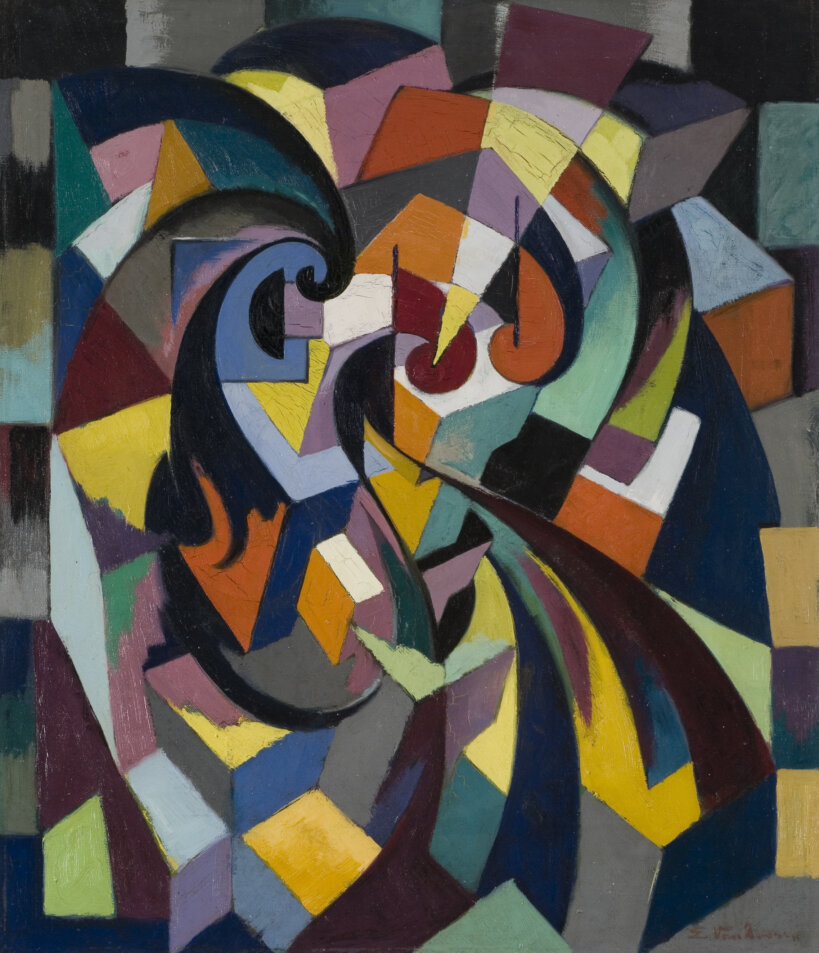In the spring of 2013, the Museum of Fine Arts Ghent (MSK) organised the exhibition ‘Modernism: Belgian Abstract Art and Europe (1912-1930)’. The exhibition principally connected back to the exhibition ‘Flemish Expressionism in a European Context 1900-1930’, in which the MSK had explored the international links between expressionism in Flanders and modern art in Europe for the first time in 1990.
‘Belgian Modernism: Belgian Abstract Art and Europe (1912-1930)’ exhibited abstraction as a counter-movement in this period from an international perspective. The exhibition focused on the various forms of abstraction favoured by Belgian artists for short or longer periods. Besides the visual arts, architecture, applied art, typography, photography, film, music, literature and theatre were used to illustrate the historic avant-garde in Belgium.
Belgian modernism: a short history
Not long before the First World War, a few exhibitions were held in Belgium that called attention to the international avant-garde. For example, futurism, cubism and abstraction could all be seen successively in Brussels, with artists such as Archipenko, József Csáky, Robert Delaunay, Albert Gleizes, Vasili Kandinsky, Henri Laurens, Fernand Léger and Jean Metzinger exhibiting their work. Although their presence did not go unnoticed, the avant-garde in Belgium had not yet found a broad support base in artistic circles.
The Belgian reception of the pre-war international avant-garde formed the introduction to the exhibition. Then the exhibition turned its attention to three key figures: Jules Schmalzigaug, Georges Vantongerloo and Marthe Donas. Each of them joined the international avant-garde – before the First World War, in Schmalzigaug’s case, but during the war years in the cases of Vantongerloo and Donas – and maintained intense relationships with its members: Schmalzigaug with the Italian futurists (Giacomo Balla, Umberto Boccioni, Gino Severini), Vantongerloo with artists in the De Stijl movement (Theo van Doesburg) and Donas with French post-cubism (Alexander Archipenko). Opting resolutely for adventures abroad, they left behind the retrograde Belgian arts scene, where late symbolism and impressionism still predominated until 1914.
A large section of the exhibition was devoted to the ‘classical’ years, 1920-1925, when the historic avant-garde in Belgium was at its peak. The exhibition followed the development of the oeuvre of major figures such as Karel Maes, René Magritte, Jozef Peeters, Victor Servranckx and Georges Vantongerloo, seeking out international lines of influence and correspondences: scenes that were sometimes rivals, but often converged.
Touchstones were provided in the contemporary proponents of De Stijl, Bauhaus, Russian constructivism and suprematism and French post-cubism and purism. In this context, the Belgian sub-genres of Zuivere Beelding and Gemeenschapskunst were discussed and looked at in relation to other art forms. Particular attention was paid to modernist architects such as Victor Bourgeois, Louis Herman De Koninck, Jean-Jules Eggericx, Huib Hoste and Louis Van der Swaelmen, but the total concept of modernism was approached more comprehensively through interior decorations, furniture and other utilitarian items. The photography and film of the time were given a prominent place.
In the second half of the war, a strong dynamic arose in both Antwerp and Brussels. Largely isolated from the rest of the world, but not entirely independent of each other, a support base for abstraction emerged in both cities. Like-minded artists came together in ‘art circles’ (Doe Stil Voort, Kring Moderne Kunst), rented studios together (e.g. Paul Joostens, Jan Kiemeneij, Jozef Peeters and Edmond Van Dooren), organised lectures (Prosper De Troyer) and exhibited their work together at the few exhibitions held during this period.
Especially after the First World War, their efforts led to an increase in pace that resulted in the emergence of numerous movements (La Lanterne Sourde, L’Equerre) and journals (L’Art Libre, Lumière, 7Arts, Ça ira!, Het Overzicht, De Driehoek). Networking was a key concept in Belgian avant-garde journals. By making texts and images available to German, French, Hungarian, Polish and Czech journals, the work of the Belgian geometric abstract artists became widely distributed.
Conversely, journals such as 7Arts and Het Overzicht introduced international artists such as Robert Delaunay, Vilmos Huszár, Lajos Kassák, Mikhail Larionov, László Moholy-Nagy, Tristan Tzara and A.C. Willink. The exhibition devoted considerable attention to these journals, because they were the bearers of new insights as well as picking up, questioning or absorbing ideas from elsewhere. The medium of the journal did not just spread theoretical ideas: visual ideas could be distributed as well, for example by printing woodcuts and linocuts. In a broader context, the exhibition also aimed to demonstrate the significance and quality of Belgian modernist typography.
Special attention was also paid to the interaction between the visual arts on the one hand and literature, music and theatre on the other. The inextricable link between the different art forms was expressed to the full in the circle La Lanterne Sourde, where the writers and poets Pierre Bourgeois and Paul Van Ostaijen organised exhibitions of modern art. Another example was the collaboration between the brothers Pierre and Victor Bourgeois, the composer Georges Monier and the visual artists Pierre-Louis Flouquet and Karel Maes for the journal 7Arts. The group L’Assaut emerged in turn from 7Arts, which concentrated on the performing arts but also organised exhibitions in Milan and Paris, with work by artists including Flouquet, Jean-Jacques Gailliard and Servranckx. Maes and Servranckx had strong links to the theatre, where they worked as a graphic designer and scenery designer. Baugniet and Magritte, in turn, designed posters, scenery and costumes for the theatre company Le Groupe Libre.
